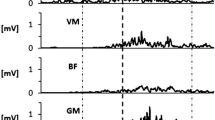Summary
For 13 subjects the performance of drop jumps from a height of 40 cm (DJ) and of countermovement jumps (CMJ) was analysed and compared. From force plate and cine data biomechanical variables including forces, moments, power output and amount of work done were calculated for hip, knee and ankle joints. In addition, electromyograms were recorded from five muscles in the lower extremity. The results obtained for DJ appeared to depend on jumping style. In a subgroup of subjects making a movement of large amplitude (i. e. bending their hips and knees considerably before pushing off) the push-off phase of DJ closely resembled that of CMJ. In a subgroup of subjects making a movement of small amplitude, however, the duration of the push-off phase was shorter, values for moments and mean power output at the knees and ankles were larger, and the mean EMG activity of m. gastrocnemius was higher in DJ than in CMJ. The findings are attributed to the influences of the rapid pre-stretch of knee extensors and plantar flexors after touch-down in DJ. In both subgroups, larger peak resultant reaction forces were found at the knee and ankle joints, and larger peak forces were calculated for the Achilles tendon in DJ than in CMJ.
Similar content being viewed by others
References
Asmussen E, Bonde-Peterson F (1974) Storage of elastic energy in skeletal muscles in man. Acta Physiol Scand 91:385–392
Basmajian JV (1974) Muscles alive; their functions revealed by electromyography. Williams and Wilkins, Baltimore, pp 23–27
Blattner SE, Noble L (1979) Relative effects of isokinetic and plyometric training on vertical jumping performance. Res Q 50:583–588
Bosco C, Komi PV (1979) Potentiation of the mechanical behavior of the human skeletal muscle through prestretching. Acta Physiol Scand 106:467–472
Bosco C, Komi PV (1980) Influence of aging on the mechanical behavior of leg extensor muscles. Eur J Appl Physiol 45:209–219
Bosco C, Pittera C (1982) Zur Trainingswirkung neuentwickelter Sprungübungen auf die Explosivkraft. Leistungssport 12:36–39
Bosco C, Viitasalo JT, Komi PV, Luthanen P (1982) Combined effect of elastic energy and myoelectrical potentiation during stretch-shortening cycle exercise. Acta Physiol Scand 114:557–565
Cavagna GA, Citterio G (1974) Effect of stretching on the elastic characteristics and the contractile component of frog striated muscle. J Physiol 239:1–14
Cavagna GA, Dusman B, Margaria R (1968) Positive work done by a previously stretched muscle. J Appl Physiol 24:21–32
Clutch D, Wilton M, McGown C, Bryce GR (1983) The effect of depth jumps and weight training on leg strength and vertical jump. Res Q exerc Sport 54:5–10
Dempster WT (1955) Space requirements of the seated operator. Wright-Patterson Air Force Base, Ohio (WADCTR 55–159)
Dietz V, Schmidtbleicher D, Noth J (1979) Neuronal mechanisms of human locomotion. J Neurophysiol 42:1212–1222
Dursenev LF, Raevsky LG (1979) Strength training of jumpers. Sov Sports Rev 14:53–55
Elftman H (1939) Forces and energy changes in the leg during walking. Am J Physiol 125:339–356
Gottlieb GL, Agarwal GC (1979) Response to sudden torques about ankle in man: myotatic reflex. J Neurophysiol 42:91–106
Gregoire L, Veeger HE, Huijing PA, Van Ingen Schenau GJ (1984) Role of mono- and biarticular muscles in explosive movements. Int J Sports Med 5:301–305
Hubley CL, Wells RP (1983) A work-energy approach to determine individual joint contributions to vertical jump performance. Eur J Appl Physiol 50:247–254
Komi PV, Bosco C (1978) Utilization of stored elastic energy in leg extensor muscles by men and women. Med Sci Sports exerc 10:261–265
Melvill Jones G, Watt DGD (1971) Observations on the control of stepping and hopping movements in man. J Physiol 219:709–727
Miller DI, Nelson RC (1973) Biomechanics of sport. Lea & Febiger, Philadelphia, pp 39–87
Schmidtbleicher D, Dietz V, Noth J, Antoni M (1978) Auftreten und funktionelle Bedeutung des Muskeldehnungsreflexes bei Lauf- und Sprintbewegungen. Leistungssport 8:480–490
Steben RE, Steben AH (1981) The validity of the stretch — shortening cycle in selected jumping events. J Sports Med 21:28–37
Viitasalo JT, Aura O, HÄkkinen K, Komi PV, Nikula J (1981) Untersuchung von Trainingswirkungen auf die Krafterzeugung und Sprunghöhe. Leistungssport 11:278–281
Wilhelm K (1974) Das Verhalten der menschlichen Achillessehne im Experiment bei statischer und dynamischer Belastung. Res Exp Med 162:281–297
Wilt F (1978) Plyometrics — what it is and how it works. Mod Athlete Coach 16:9–12
Author information
Authors and Affiliations
Rights and permissions
About this article
Cite this article
Bobbert, M.F., Mackay, M., Schinkelshoek, D. et al. Biomechanical analysis of drop and countermovement jumps. Europ. J. Appl. Physiol. 54, 566–573 (1986). https://doi.org/10.1007/BF00943342
Accepted:
Issue Date:
DOI: https://doi.org/10.1007/BF00943342




